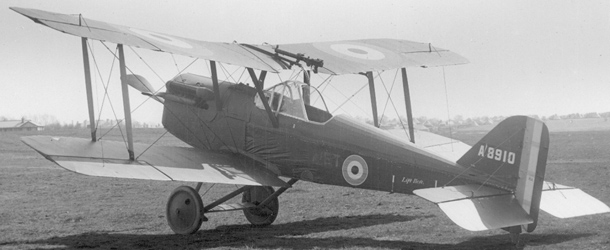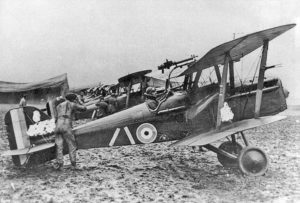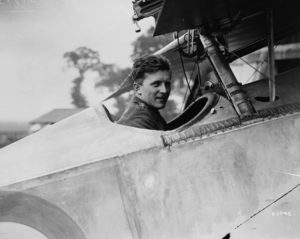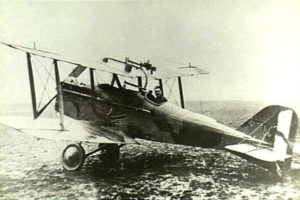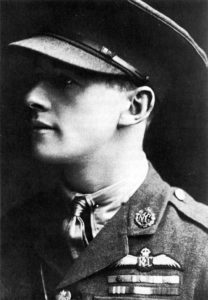Following the Pfalz D.III preview article, it’s time to learn more about the RAF SE.5, the second fighter just released in the new series of WW1 Wings of Glory Airplane Packs.
The SE.5 (Scout Experimental 5) was designed around a new and powerful engine, one which unfortunately was cranky and unreliable. The first pilots to fly the plane were very unimpressed (Albert Ball hated it and kept his Nieuport!). But after only 77 SE.5s were built, production changed to the SE.5a. This model had a more powerful and much more reliable 200hp Hispano engine, and was made even better by a Wolsley Viper copy. Thus, a classic plane was born.
The SE.5a managed to be both inherently stable and easy to fly, while also being extremely maneuverable. It was sturdy - able to withstand high speed dives - and also one of the fastest planes of the war.
Unfortunately for the Allies, the “improved” engine was in short supply. While the first SE.5s were on the Western Front at the end of “Bloody April” in 1917, the engine problems (both mechanical and availability) kept early production low and only a single squadron was equipped with the plane for the remainder of that year. It was not until the following year there were large numbers in action. Fortunately, they made an impact. While the SE.5a was not as “tight” a dogfighter as the Sopwith Camel, it was much easier (and safer) to fly. It was fast, agile, an excellent gun platform, and particularly good at high altitude, making it one of the best Allied opponents for the Fokker D-7.
By the end of the war, SE.5s were outfitting 23 squadrons, including Canadians, Australians, and even 2 U.S. It was the favored plane of many of the top Allied aces – including all three of the versions featured in the Wings of Glory Airplane Packs.
Armament for the SE.5 was one synchronized Vickers machine gun, as well as a Lewis gun firing over the top wing. The latter one using a “Cooper” mount for easier change of the ammunition drum by pulling the gun closer to the pilot. Many pilots used this device to fire the gun upwards, as they flew below an enemy. This is reflected with some special rules and cards for all the SE.5 models in the packs. Other cards vary according to pilot skills.
SE.5 in Wings of Glory
The SE.5 is featured in Wings of Glory Airplane Packs with a SE.5 piloted by William “Billy” Avery Bishop and two SE.5a used by Roderic Dallas and James McCudden.
Canadian ace Billy Bishop was one of the top scoring pilots of the war, and special cards are included which capture his shooting skills. While there are controversies about some of his victories, and especially his Victoria Cross episode, there is no disputing that he was an excellent combat pilot and became a good commander.
Like many other pilots, he entered the war in a cavalry unit but found he was unsuited to trench warfare (as a pilot he was known to wash his hands dozens of times each day). He transferred to the RFC accepting an observer position since there were no pilot slots available at the time. He served in France from January to April 1916, badly injuring a knee during a crash landing. Recuperating in London he befriended a socialite with important connections, which allowed him to return to Canada for full recovery and enter flight school when he returned to England in September.
His pilot career began flying B.E.2s to defend London from Zeppelins in November 1916, but he soon transferred to France, where he joined 60 Squadron. and began a glorious career in the Nieuport 17. His score rose slowly until he began flying many “lone wolf” missions in addition to squadron duties. Initially very rash in combat, he adjusted his style after his mechanic counted 210 bullet holes in his plane after one mission. Then, stealth and surprise became his allies and his score increased very quickly, including a solo dawn attack on a German aerodrome (which earned him the VC.)
He was the highest scoring Allied pilot when he went on leave in the fall of 1917 and assigned to various duties until returning to France in May 1918 to take command of 85 Sqd. His scoring renewed at an extraordinary rate, with nine victories from May 22 to June 1. The government of Canada worried about the blow to morale that losing Bishop would mean and ordered him to leave France by noon of June 19 to help organize the new Canadian Flying Corps. He flew constantly those last days, claiming five victories in 15 minutes on his last morning of combat, giving him a final total of 72 - although a number of historians have questioned these numbers.
Between the wars he engaged in several activities, mostly flying related, and became the first Canadian Air Vice Marshal and Air Marshal when WW2 began. He organized a highly successful recruiting and training program before resigning in 1944 due to ill health. He died in his sleep at age 62 in September 1956.
Bishop’s SE.5 model includes special cards focusing on his amazing marksmanship as well as his great daring and bold combat approaches.
Rejected by the RFC, Roderic Dallas began his service with the Royal Naval Air Service in August 1915. Although he did all his flying with British, rather than the Australian Air Force, he was one of the top-scoring pilots from Australia. He flew Caudrons, Nieuport 11s, and was one of the earliest pilots for the Sopwith Triplane, which became his favorite mount. He took command of 1 Squadron RNAS in June 1917, still flying Triplanes, and combined excellent aerial tactics with sound leadership and specialized training for new pilots, turning 1 Squadron into one of the RNAS’s best. The unit converted to Sopwith Camels and became part of the Home Defense network from November 1917 to February 1918, when it went back to France.
When the RAF was formed in April of that year, Dallas became the squadron commander for 40 Squadron, flying SE.5s. This former RFC unit first looked upon their “naval” commander with suspicion but soon recognized his qualities as a commander. He died in combat June 1918, without learning that he had been promoted to Lt. Colonel and ordered to stop flying. His victory total is generally considered to be 39 (second highest for Australians) but he had a casual attitude about making claims and his total could be over 50. He left a legacy of leadership and training standards that served Allied air services well.
His model’s special cards capture some of his qualities as a squadron commander, as well as a sharp-eyed Ace of special skills.
While it was common for German fighter pilots to begin their flying careers as observers, this was a rare thing in the RFC. James McCudden had been in the Royal Engineers but his interest in flight led him to becoming an air mechanic and then an observer before the war began. His early war career saw him overseeing other mechanics and flying missions as an observer.
His initial requests to become a pilot were rejected because he was considered too valuable as a mechanic. After becoming a pilot in mid 1916, he eventually became the most highly decorated British airman, achieving 57 victories. He flew Fe2s, DH-2s, and Sopwith Pups, but gained most of his success in the SE.5. He said the following about the plane: "It was very fine to be in a machine that was faster than the Huns, and to know that one could run away just as things got too hot." McCudden joined Squadron 56 in August 1917. Though it was already considered a very good unit, McCudden’s leadership skills and mechanical aptitude turned it into one of the most successful on the Western Front.
He was rotated back to England in March 1918, for promotion, decorations (including the Victoria Cross), and rest. He was assigned to take over Squadron 60 in July 1918 but died in a takeoff crash while in the process of returning to France. He had two brothers who both died flying in the RFC.
To reflect McCudden’s mechanical improvements to his plane, his model comes with an “Enhanced SE.5” card that allows for increased altitude and slightly improved turning performance, as well as his remarkable intuition and abilities to get out of trouble when he needed to.
Information sources: The Aerodrome, Wikipedia , "The S.E.5: Historic Military Aircraft No. 5", Bruce, J.M. (Flight, 17 July 1953), "Britain's Greatest Aircraft", Jackson (Pen and Sword, 2007), "McCudden, VC", Cole (William Kimber, 1967), "Fighter Aircraft of the 1914–1918", WarCheesman (Letchworth: Harleyford, 1960), "James McCudden VC", Revell (Albatros Productions, 1987), "Aces Falling: War Above the Trenches, 1918", Hart (Weidenfeld & Nicolson, 2007), "Australian Hawk Over the Western Front: A Biography of Major R S Dallas DSO, DSC, C de G Avec Palme", Hellwig (Grub Street, 2005); "The Making of Billy Bishop: The First World War Exploits of Billy Bishop, VC." Greenhous, Brereton (Dundurn Press Ltd., 2002), "Billy Bishop: Canadian Hero", McCaffrey, (James Lorimer & Company Publishers, 1988).

